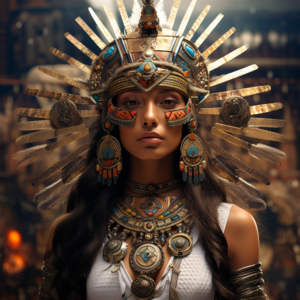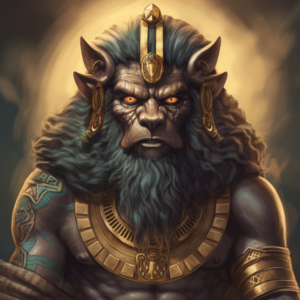Bes is the Egyptian god of war and domestic protection. He was also worshiped as a god of fertility, music, dancing and gaiety. He was predominantly viewed as protector of households, especially of mothers and children during childbirth. In this manner he held a very similar role to the goddess Bastet. Although he is viewed as a minor god of ancient Egypt, Bes is a complex deity with many aspects.
Origins
Bes most likely already existed in the Old Kingdom of Egypt but only became prominent during the New Kingdom. Some theories have it that he was originally from sub-saharan Africa, and did not originate in Egypt. In his earliest inception, he was said to be a lion.
Appearance
He is sometimes depicted as a bearded dwarf with an ugly appearance intended to scare evil spirits away. In most images of him, he sticks out his tongue and shakes a rattle. He also has prominent genitals, bow legs, and a tail. On his head, he often wears a crown or plumed headdress. Despite his scary appearance, the people of Egypt were not afraid of Bes.
Family
Mention is made of two wives belonging to Bes. The one was Taweret and the other Beset. Not much is known about other family relationships, including who his parents were.
Symbols
The Sa symbol, which means “protection of young life,” is associated with Bes and his wife Taweret. Because of his origin, he is also affiliated with lions.
Powers & Duties
He originally protected the pharaoh, but quickly became popular among ordinary Egyptians who put his statue up at their homes to scare away demons. As household protector, he would fight off dangerous animals, such as snakes and scorpions.
Bes was often associated with Horus the child. Being the god of childbirth who protected the birthroom and the mother, he is even said to have entertained the newborn with music and dancing, making the baby smile. Due to his stature as protector of homes and childbirth, a picture of him was present in many birthhouses.
Worship
During the time of his worship, Bes was associated with more prominent Egyptian gods such as Amun and Hathor. The latter was the goddess of childbirth, dancing and music. In later historical periods, Bes became known and worshipped among the Phoenicians and the Cypriots. Images of him were also found during the Persian Empire, when he gradually came to be depicted in Persian clothes and headdresses.
Facts About Bes
- There are numerous similarities between Bes and Bastet. Bes is a male protector of the home, and Bastet is a female protector of the home.
- Entertainers and prostitutes often had a tattoo of Bes on their bodies. Thought to have belonged to entertainers of the New Kingdom, Masks and costumes in the likeness of Bes were discovered by archaeologists.
- During the Ptolemaic period, special chambers were built with the images of Bes and a naked goddess (thought to have been Beset) on the walls. Egyptians went there in search of healing;
- In some ancient Egyptian images, Bes wears a soldier’s uniform or a kilt; in others, he is covered in the skin of a panther;
- As a protector against evil, Bes gradually became associated with the good things in life, including music, dance, and sexual pleasure;
- In his capacity as a private, household god, images of Bes were found on personal articles like mirrors and vases;
- Because he celebrated childbirth by loudly playing musical instruments, Bes is also considered to be the creator of loud music;
- The title “Lord of Nubia” supports the belief that Bes was originally from Africa. A tribe of dwarves was supposed to have lived in Nubia (now Ethiopia). The Nubian word for “cat” is “besa.” The long tail that he is often pictured with supports this theory;
- Unlike other Egyptian gods who were normally shown in profile, Bes is commonly shown facing forward. His image often appears on knives, on “magic wands,” and on amulets; it is thought the bearer of these objects would fall under his protection;
- No known temple was dedicated to Bes and he had no priests, although his image appears in temple reliefs in Thebes;
- A less popular theory concerning Bes suggests that he was a composite god made up of ten different gods during the Ptolemaic period of Egyptian history. The gods were Bes, Amam, Hayet, Aha, Ihty, Menew, Sopdu, Mafdjet, Tetenu, and Segeb;
- Ibiza, the Balearic island, was named after Bes by Phoenician settlers after they discovered no dangerous creatures on it. The island was called Ebusus under Roman rule;
- In modern literature, Bes is a character in Rick Riordan’s The Kane Chronicles and Neil Gaiman’s The Sandman: Season of Mists.






